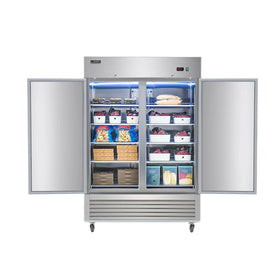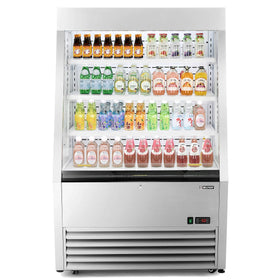When the weather gets hot, I always find myself avoiding the stove. The idea of cooking a full meal feels like too much, and I end up just grabbing something cold—usually yogurt, fruit, or whatever’s easy in the fridge. But after a few days of that, I started craving something with more bite. That’s when I tried making refrigerator pickles at home. I was surprised how easy it was—just a few vegetables, some vinegar, and spices. After a couple of days in the fridge, they turned out crisp, tangy, and seriously satisfying. Now I always keep a jar ready. It’s the perfect summer snack—cool, refreshing, and homemade.
This instant pickle is easy to make, doesn't require a fermenter, and adds a refreshing flavor to everyday meals like burgers, sandwiches, and salads. With just a few vegetables, simple ingredients, and a clean jar, you can create delicious pickles in just a few days that will bring a refreshing touch to your summer table.

Why Refrigerator Pickles Are Great for Beginners
Many people think making pickles is complicated, but refrigerator pickles aren't difficult, on the contrary they're simple:
- Simple: No fermenting or canning required
- Quick: Ready to eat in 2-5 days, so little time is needed.
- Flexible: Make as much or as little as you want.
- Customizable: Adjust flavors and spice levels to suit your preferences.
A Little Way to Make Pickles Easy: The 3-2-1 Rule
The 3:2:1 ratio is a balanced guideline for pickle recipes for beginners.
Ratio: 3 parts vinegar: 2 parts water: 1 part sugar

Why does it make pickles easy?
- Vinegar keeps the vegetables flavorful and adds acidity.
- Sugar balances the acidity and mellows the flavor; especially with sweet pickles or bread and butter pickles.
- Water dilutes the solution so that it is not too sharp, making pickles more palatable.
To this add
Add 1 tablespoon kosher salt to every 2-3 pint jars to prevent vegetables from spoiling.You can add different spices to taste as you like (see below)
Also, for the vinegar, you can choose to use white vinegar, apple cider vinegar, or rice vinegar, which are lighter in color and will make the pickles look better and taste more refreshing. Be sure to use cooled boiled or filtered water so that chlorine or hard water does not affect taste or safety.
Step-by-Step: How to Make Refrigerator Pickles (with Tips)
1. Prepare Jars
Sterilizing glass jars by washing them thoroughly in boiling water will make pickles safer. Even if they don't need to be sterilized, clean jars will reduce the risk of your pickles going bad.
2.Slice the vegetables
Into uniform shapes: spears, coins, chunks, or strips; they can be cut into any shape you like. Thin slices pickle faster, and consistent size ensures even flavor. It's okay if you slice unevenly, even uneven flavor can be a pleasant surprise.
3. Add seasonings and vegetables
Place vegetables and seasonings (spice packets) in jar. Leave about ½ inch of space at the top. Press down gently, being careful not to crush.
4. Make brine
Combine vinegar, water, sugar and salt in a saucepan. Heat until sugar and salt are dissolved. Do not boil; it is good to have all the ingredients dissolved. Let cool slightly before pouring so that the flavor of herbs such as dill or garlic is retained.
5. Pour in brine
Cover vegetables completely with brine. Tap the jar or stir gently with a clean stick to remove air bubbles. Make sure to soak evenly to prevent premature spoilage.
6. Seal and Refrigerate
Tighten lids and place in refrigerator immediately. Keep sealed for 48-72 hours to allow the flavors to fully develop.
7. Wait and Enjoy
Taste after two days. Most kimchi can be made in 3-5 days. Some harder vegetables (such as beets or watermelon rinds) may take longer.
Customize your own flavorful spice packets
To make the process faster and more flavorful, pre-make spice packets to suit your needs. Store them in small jars or bags for easy use next time. Suggested ingredients include:
- Garlic cloves
- Dried chili flakes or whole dried chili peppers
- Black pepper or peppercorns
- Bay leaves, dill seeds, mustard seeds
- Cinnamon stick, cloves or ginger (sweet or exotic)
Choose a flavor direction or mix and match. Once you find your favorite combination, label and store it - when you want a pickle, just grab a packet and add it to the cooled brine.

Popular Refrigerator Pickle Recipes (1–2 Servings)
Each recipe makes roughly one pint (16 oz / 470 ml) of refrigerator pickles. Use a clean, wide-mouth pint mason jar with a tight-sealing lid. Always store in the refrigerator.
1. Garlic Dill Pickles
Vegetables: 2 small cucumbers (kirby/pickling type), sliced into spears or rounds
Brine:
- 1 cup white vinegar
- ½ cup water
- 1 tbsp kosher salt
Spices:
- 2 garlic cloves (smashed)
- 2 fresh dill sprigs
- 1 tsp mustard seeds
- ½ tsp whole black peppercorns
Best with: Sandwiches, burgers, charcuterie
Time: 2–3 days
2. Bread and Butter Pickles
Vegetables: 1 small cucumber + ¼ small onion, thinly sliced
Brine:
- 1 cup apple cider vinegar
- ½ cup water
- ¼ cup sugar
- 1 tbsp kosher salt
Spices:
- 1 tsp celery seed
- ½ tsp ground turmeric
Best with: BBQ meats, fried chicken, sliders
Time: 3 days
3. Sweet Pickles
Vegetables: 1 small cucumber + ½ small carrot (julienned)
Brine:
- 1 cup white vinegar
- ½ cup water
- ⅓ cup sugar
- 1 tbsp salt
Spices:
- 1 small cinnamon stick
- 2 whole cloves (optional)
Best with: Curry, sandwiches, roasted meats
Time: 3–4 days
4. Kosher Dill Pickles
Vegetables: 3–4 small pickling cucumbers (whole or halved)
Brine:
- 1 cup water
- 1 cup white vinegar
- 1 tbsp kosher salt
Spices:
- 1 tsp dill seeds or 2 sprigs fresh dill
- 2 garlic cloves
- ½ tsp black peppercorns
- 1 small bay leaf
Best with: Pastrami sandwiches, as a snack
Time: 3 days
5. Dilly Beans
Vegetables: 20–25 trimmed green beans
Brine:
- 1 cup white vinegar
- ½ cup water
- 1 tbsp kosher salt
Spices:
- 2 garlic cloves
- 2 sprigs fresh dill
- 1 tsp mustard seeds
Best with: Bloody Marys, grilled meats, lunch boxes
Time: 2–3 days
6. Pickled Beets
Vegetables: 2 medium beets, cooked, peeled, and sliced
Brine:
- 1 cup apple cider vinegar
- ½ cup water
- 2 tbsp sugar
- 1 tsp salt
Spices:
- 1 small cinnamon stick
- 2 whole cloves
- 1 bay leaf
Best with: Goat cheese salads, cold platters
Time: 4–5 days
7. Pickled Okra
Vegetables: 8–10 small fresh okra pods
Brine:
- 1 cup white vinegar
- ½ cup water
- 1 tbsp kosher salt
Spices:
- ½ tsp chili flakes
- 2 garlic cloves
- 1 tsp mustard seeds
Best with: Fried dishes, cheese boards, Southern meals
Time: 3–4 days
8. Pickled Watermelon Rind
Vegetables: 1 cup peeled, diced watermelon rind (white part only, no red flesh)
Pre-treatment: Simmer rind in boiling water for 5 minutes, drain before pickling
Brine:
- 1 cup apple cider vinegar
- ½ cup water
- ¼ cup sugar
- 1 tsp salt
Spices:
- 2 slices fresh ginger
- 1 small cinnamon stick
- ¼ tsp red pepper flakes
Best with: Grilled meats, rice dishes, cold noodles
Time: 5 days
9. Ill Pickle (Viral Style Remix)
Base: 1 cup pre-made dill pickle slices (store-bought or homemade)
Add-ins:
- 1 tsp ranch seasoning
- 1 tsp hot sauce
- ½ tsp chili flakes
Method: Add ingredients directly into jar of pickle slices, shake well, chill overnight
Best with: Fried food, as a bold snack
Time: 1 day (no-cook remix)
How Long Do Refrigerator Pickles Last?
Refrigerator pickles have the best flavor after soaking in brine for 3 to 5 days. Although they are usually ready to enjoy quickly, soaking them for a few more days allows the flavors to fully ferment and penetrate the vegetables. When properly stored in clean, airtight containers in the refrigerator, vegetables can stay crisp and flavorful for up to two weeks. The exact shelf life depends on the type of vegetables used and how clean they are during preparation. Always use clean utensils when working with pickles - to prevent potential bacteria that can shorten their shelf life. If you notice any unusual cloudiness, odors, or bubbles in your jars, it's best to discard the batch of pickles.

Best Pairings for Pickles
- Burgers & Sandwiches
Adding classic dill pickles or bread and butter pickles creates a sharp, crunchy contrast that enhances the flavor of meat, cheese or vegetable fillings.
- Grilled and Roasted Vegetables
Pair pickled okra or pickled beets with smoky grilled flavors for a balance of sweetness and flavor that also eliminates the greasiness of grilled meats.
- Salads and Grain Bowls
Add sweet pickled carrots to leafy greens or rice bowls to add brightness and acidity while adding crunch.
- SNACK PLATES AND CHEESE PLATES
Add a variety of pickled cucumbers to a grilled meat or cheese board for flavor and texture.
- Everyday Meals
Add pickled cucumbers as a flavoring element to burritos, quesadillas, or even pasta salad-they're more than a side dish, they're a secret ingredient.
Why You Should Start Pickling Now
Refrigerator pickling is one of the easiest and most rewarding ways to bring bold, fresh flavors into your kitchen. You don't need any special equipment, canning experience, or long wait times. It's a fast, flexible, low-effort way to preserve vegetables and bring in new experimentation opportunities, perfect for home cooks, busy families, and anyone who wants to make the most of their groceries. You can adjust the spices, sweetness or acidity to suit your tastes. Most importantly, it's satisfying. Turning a handful of fresh vegetables into a vibrant homemade treat is a delight.










